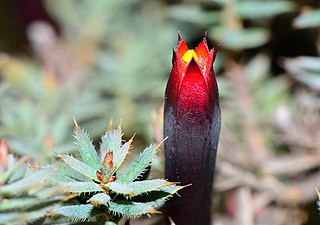
Leucopogon pendulus is a species of flowering plant in the heath family Ericaceae and is endemic to the south-west of Western Australia. It is an erect, straggling shrub with oblong leaves and white, tube-shaped flowers that are bearded inside.

Styphelia coelophylla is a plant in the family Ericaceae endemic to the south west of Western Australia. It is an erect, bushy shrub with egg-shaped to lance-shaped leaves and tube-shaped flowers.

Styphelia cordifolia, commonly known as heart-leaved beard-heath, is a species of flowering plant in the heath family Ericaceae and is endemic to Australia. It is an erect shrub with broadly egg-shaped to round leaves, and white, tube-shaped flowers, the petals bearded on the inside.

Styphelia flavescens is a species of flowering plant in the heath family Ericaceae and is endemic to the south-west of Western Australia. It is a shrub with oblong leaves and white, tube-shaped flowers that are densely bearded on the inside.

Styphelia glaucifolia is a species of flowering plant in the family Ericaceae and is endemic to the south-west of Western Australia. It is an erect or spreading shrub with linear, sharply-pointed leaves, and white, tube-shaped flowers.

Styphelia insularis is a species of flowering plant in the heath family Ericaceae and is endemic to the south-west of Western Australia. It is a rigid, scrubby shrub with many branches, linear or oblong leaves and tube-shaped, white flowers.

Styphelia erubescens is a species of flowering plant in the heath family Ericaceae and is endemic to the south-west of Western Australia. It is an erect shrub with variably-shaped leaves with a small, sharp point on the tip, and white, pink or red, tube-shaped flowers.

Leucopogon rotundifolius is a species of flowering plant in the heath family Ericaceae and is endemic to the south of Western Australia. It is an erect, bushy shrub with round or egg-shaped leaves, the narrower end towards the base, and white, tube-shaped flowers arranged in leaf axils in groups of 2 or 3.

Leucopogon woodsii, commonly known as nodding beard-heath, is a species of flowering plant in the heath family Ericaceae and is endemic to southern continental Australia. It is a slender shrub with more or less erect, egg-shaped leaves, and pendent white, tube-shaped flowers with densely bearded lobes.

Styphelia capillaris, commonly known as Horts' styphelia, is a species of flowering plant in the heath family Ericaceae and is endemic to a small area of south-western Western Australia. It is a dense, spreading shrub with narrowly egg-shaped to narrowly elliptic leaves and white flowers arranged singly or in pairs in leaf axils.

Styphelia ciliosa is a species of flowering plant in the heath family Ericaceae and is endemic to a small area of Western Australia. It is usually an erect shrub with narrowly elliptic to narrowly egg-shaped leaves with the narrower end towards the base, and white flowers usually arranged in pairs in leaf axils.
Styphelia compacta is a species of flowering plant in the heath family Ericaceae and is endemic to the south-west of Western Australia. It is a widely spreading or prostrate, much-branched shrub with egg-shaped leaves or lance-shaped leaves with the narrower end towards the base, and red flowers arranged in leaf axils.
Styphelia deserticola is a species of flowering plant in the heath family Ericaceae and is endemic to inland Western Australia. It is an erect shrub with sharply-pointed, narrowly egg-shaped leaves and white or pale cream-coloured, tube-shaped flowers usually arranged in groups of 2 or 3 in leaf axils.

Styphelia discolor is a species of flowering plant in the heath family Ericaceae and is endemic to the south-west of Western Australia. It is a shrub, usually with prostrate stems and spreading, tapering linear leaves and almost sessile red flowers.
Styphelia exserta is a species of flowering plant in the heath family Ericaceae and is endemic to the south-west of Western Australia. It is an erect shrub with broadly egg-shaped leaves, and white, tube-shaped flowers.

Styphelia hainesii is a species of flowering plant in the heath family Ericaceae and is endemic to the south coast of Western Australia. It is a bushy shrub with egg-shaped leaves, the narrower end towards the base, and red, tube-shaped flowers arranged singly in leaf axils.
Styphelia intertexta is a species of flowering plant in the family Ericaceae and is endemic to southern Western Australia. It is a much-branched shrub with woolly-hairy branchlets, narrowly triangular to linear, sharply pointed leaves, and white flowers with turned-back lobes that are bearded inside.

Styphelia kingiana is a species of flowering plant in the heath family Ericaceae and is endemic to the south-west of Western Australia. It is an erect, compact shrub with sharply pointed, egg-shaped leaves, and white, tube-shaped flowers arranged in clusters near the ends of branchlets.

Styphelia lissanthoides is a species of flowering plant in the heath family Ericaceae and is endemic to the south of Western Australia. It is an erect, bushy shrub with egg-shaped to lance-shaped leaves with the narrower end towards the base, and white, tube-shaped flowers arranged singly or in pairs in leaf axils.

Styphelia microcalyx, commonly known as native cranberry, is a species of flowering plant in the heath family Ericaceae and is endemic to the south west of Western Australia. It is a much-branched, erect or diffuse shrub with linear or narrowly oblong leaves and red, tube-shaped flowers that are bearded inside.

















